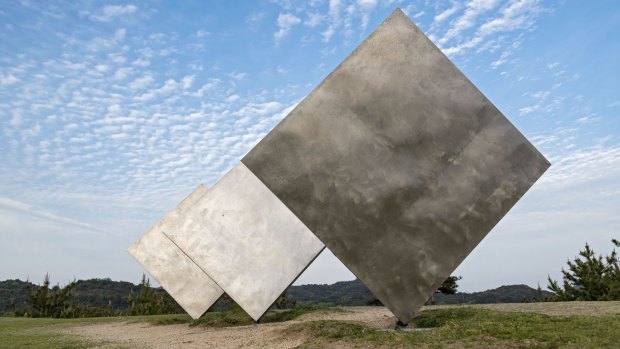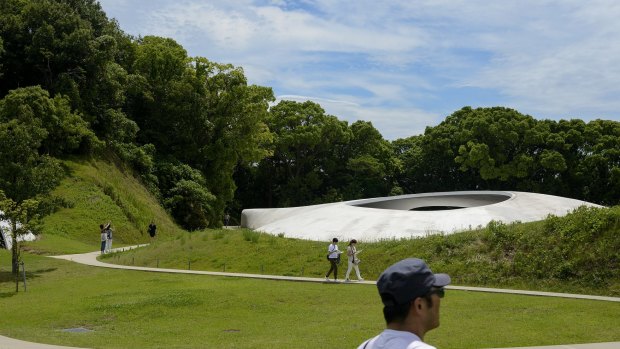This was published 2 years ago
The Setouchi Triennale art festival 2022: Festival on Seto Inland Sea dodges COVID
By Keith Austin

George Rickey's 'Three squares' art installation in Naoshima, Japan. Credit: Getty Images
The Setouchi Triennale art festival, which features more than 150 works scattered across 12 islands in Japan's little-known Seto Inland Sea, happens (as the name suggests) every three years. The last one was in 2019 and plans are now in hand – COVID willing – for next year's event.
It's as if the festival, which was started in 2010 to try to bring tourism to an area that was suffering from depopulation, has cleverly leap-frogged the pandemic (insert hashtag "wishful thinking" here, please).
Very little is known about specific artworks for 2022 due to the difficulty of getting artists into Japan to visit the sites, but tentative dates have been announced for the festival's usual spring, summer and autumn tranches. These are April 14-May 18, August 5-September 4 and September 29-November 6.

Teshima Art Museum.Credit: Getty Images
The festival has, in past years, been a massive success, with many thousands of visitors flocking to the area during its run.
But if you can't hang on until 2022, or perhaps want to wait until 2023 to be pandemic-safe, the good news is that many of the best artworks can be seen all year around. It also helps that it's held in a beautiful region of Japan that somehow remains off the beaten tourist track.
There are 700 or so islands and islets scattered across the Seto Inland Sea, one of the largest of which is Shikoku Island. It's from here, from the port of Takamatsu, that ferries set out to the art islands.
And on a trip pre-COVID it's on one of these islands – Teshima – that I hear our guide's heart stop.
Unlike the majority of the Triennale's artworks, Les Archives du Cœur by French artist Christian Boltanski, is permanent and housed in what looks like a nondescript wooden shed hard by a sandy beach.
The shed houses an archive of the heartbeats of thousands of people worldwide that Boltanski has been recording since 2008. Inside, you can listen to these heartbeats in the Heart Room – a powerful experience in which light flashes on and off in time to the heartbeat being played - and even record your own to be added to the collection (for a fee).
Our guide, Aya Komura, has been here before and her heartbeat is on the searchable database in the Listening Room. It's an odd thing, to listen to the heartbeat of the person standing next to you – especially when you turn it off and they don't drop dead.
Teshima also has the Teshima Art Museum, which isn't really a museum at all except in so far as the building itself - essentially one piece of astonishing architectural art - IS the museum. This, too, is open all year round, every year.
Created by artist Rei Naito and architect Ryue Nishizawa, the building looks like some sort of pod-like spaceship. It's been described as shaped like a water droplet at the moment of landing.
Sitting in the corner of a rice terrace overlooking the ocean the building is a simple concrete shell - imagine slicing a gigantic white eggshell in half lengthwise- covering a space of 60 by 40 metres with no interior support.
There are two oval openings at either end to allow in the wind, sounds and light of the outside world. The concrete floor is slightly uneven and studded with small holes through which droplets of water continuously bubble. No shoes or cameras are allowed inside.
It's a harmonious, ever-changing interconnection between nature, architecture and art that manages to be both exciting and oddly tranquil.
Naoshima is one of the other main art islands (though Shodoshima hosts the most artworks during the Triennale). Here, you can visit the Benesse Art Site and the Chichu Museum. Chichu, built mostly underground to avoid blighting the natural landscape, features permanent, site-specific artworks by James Turrell and Walter de Maria.
Turrell's use of light and space as art comes to extraordinary fruition here and there are usually queues of people waiting to have their minds bent by his Open Field work. To explain further would ruin the surprise but his use of light and perspective is wonderfully disorienting.
Walter de Maria's Time/Timeless/No Time installation is monumental in scope and consists of a cavernous hall with an immense central staircase that wouldn't be out of place in some sprawling sci-fi epic. Midway up this grand flight of stairs is a massive, polished granite sphere. There are 27 golden geometric sculptures positioned around the walls, and openings in the ceiling to allow natural light into the room.
There is also a space in the museum specifically built to house five paintings from Claude Monet's Water Lilies series and which, again, relies on natural light to enhance and change the experience depending on the time of day.
There are some who say Chichu is one of the finest art museums in the world, and they wouldn't be far wrong. What's even more extraordinary is that the building (itself a work of art) was designed by Tadao Ando, an Osaka-born architect who is entirely self-taught and who gave up a boxing career to try his hand at design.
His life and works are celebrated in Honmura, the largest village on the island. Half a dozen or so of the houses in this quiet old village have been turned into art installations by the Art House Project.
James Turrell has another work here – his pitch-black Back Side of the Moon project – but it's so popular that we can't get in to see it. Instead, we turn to the Ando Museum. Parked behind the dark wooden façade of a traditional Japanese house is a beautiful concrete labyrinth dedicated to the life and works of Tadao Ando – and all designed by, wait for it, Tadao Ando.
It was on Naoshima that you also used to be able to catch a couple of Yayoi Kusama's iconic polka dot pumpkins. The red pumpkin near the ferry terminal remains but the smaller yellow pumpkin (which sat on the end of a short pier and launched many thousands of Instagram posts) was washed away by a typhoon in August this year.
After being bounced around in the turbulent waters of Typhoon Lupit, the badly battered artwork was rescued by art museum staff. It is currently being restored, and there are plans to reinstate it to its iconic location, but it's unknown if it will be ready for Setouchi 2022.
THE DETAILS
FLY
Cathay Pacific flies to Japan via Hong Kong. See cathaypacific.com.au
TOUR
Inside Japan Tours offers small group tours, tailored self-guided adventures and cultural experiences in Japan. Its 14-night Art and the Inland Sea self-guided adventure includes exploration of the Setouchi region and stays at Benesse House, the famous "art hotel" on Naoshima island. See insidejapantours.com/au/self-guided-japan-holidays/i-asis/art-and-the-seto-inland-sea/ for details.
STAY
Inside Japan Tours chooses hotels based on the individual traveller's needs and budget. At Takamatsu we stayed at the JR Clement Inn, a modern hotel right next to the train and bus station. See jrclement.co.jp/inn/takamatsu
ON THE ISLAND
The easiest way to get around Naoshima or Teshima islands is by bike (electric or otherwise), taxi or shuttle bus. See setouchiexplorer.com/art-setouchi
Japan is currently closed to tourists. For updates, see smartraveller.gov.au
Keith Austin was a guest of Inside Japan Tours and Cathay Pacific
Sign up for the Traveller Deals newsletter
Get exclusive travel deals delivered straight to your inbox. Sign up now.